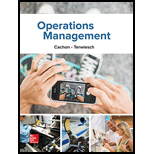
Concept explainers
It is costly to hold inventory, but inventory can also be useful in a process because
- a. adding inventory to a process will shorten the average time a unit spends in a process.
- b. adding inventory to a process can help reduce situations in which sales are lost due to uncertain demand.
- c. adding inventory to a process is likely to increase quality.
- d. adding inventory to a process will increase the profit margin of the item.
To determine: The advantage of using inventory.
Explanation of Solution
Determine the advantage of using inventory:
Even though holding inventory costs for the firm, it will be useful for the company to avoid stock-outs. Adding inventory helps the firm to manage the situation in which the products go out-of-stock due to uncertain demand. It might lead to loss of sales. Adding inventory helps to avoid this.
Hence, option (b) is correct and options (a), (c), and (d) are incorrect.
Want to see more full solutions like this?
Chapter 10 Solutions
Operations Management
Additional Business Textbook Solutions
Business in Action (8th Edition)
Principles Of Operations Management
Principles of Operations Management: Sustainability and Supply Chain Management (10th Edition)
Loose-leaf for Operations Management (The Mcgraw-hill Series in Operations and Decision Sciences)
Operations Management: Sustainability and Supply Chain Management (12th Edition)
Operations and Supply Chain Management 9th edition
- Which of these reasons to keep inventory can lead to improved quality? It allows processes to flow more smoothly. It makes deliveries more reliable. It helps to deal with short term demands. It enables the best material to be sorted prior to production.arrow_forwardWhich of the following is a valid approach to introduce safety stock for dependent demand items? None of the other answer choices are correct. Safety stock is never introduced for dependent demand items A, B, and C are all valid approaches A. Increase the replenishment order by a quantity specified by some estimate of expected plan error B. Add Safety Time into the requirements plan C. Utilize statistical techniques to set safety stocks directly for a dependent demand itemarrow_forwardThere is high utilization of inventory in chase approach O a. True O b. Falsearrow_forward
- Which of the following does NOT belong to ordering costs? A. interest payments B. clerical support C. cost of supplies D. order processingarrow_forwardInventory order is placed when O a. Only when projected or actual stocks on hand is below zero O b. None of these O c. Only when projected or actual on hand stocks are higher than the safety stock. O d. Only when projected or actual on hand stocks value is positive.arrow_forwardIf the order quantity doubles but the flow rate remains constant, what happens to theaverage amount of time a unit spends in inventory?a. Decreases by more than 50 percent d. Increases by 50 percentb. Decreases by 50 percent e. Increases by more than 50 percentc. Remains unchangedarrow_forward
- Which of the following would be included in inventory carrying cost calculation? a. Order Processing b. Inventory Control c. Warehousing and Storage d. Traffic and Transportation e. Return Goods Handlingarrow_forwardRefers to the range of the number of items produced by the operation over a given period of time.(1) Volume of output.(2) Variation of output.(3) Variety of output.(4) Transformation process.(5) Transmission procesarrow_forwardLigo's batch of 1,000 boxes of canned sardines gets manufactured in the first week of the month, and another batch of 1,000 in the second week. The batch produced first gets delivered to the warehouse and must be sold first. Ligo uses this inventory method which follows the logic that to avoid obsolescence, they should sell the oldest inventory items first and maintain the newest items in inventory. A) First in, first out B) Last in, first out Just in timearrow_forward
- Which of the following is true for inventory control: Select one a . Economic order quantity has minimum cost per order b . All the options are correct c . Inventory carrying cost increases with quantity per order d. Ordering cost decreases with lot sizearrow_forwardStatement 1 – For providing higher service levels an organization must hold higher levels of inventory. Statement 2 – A perfect order is a key measure of supply chain performance a. True, True b. False, True c. True, False d. False, Falsearrow_forwardEdwarldo’s Manufacturing uses 2,400 units of a product per year on a continuous basis. The product Carrying Cost are $60 per year and Ordering Cost are $250. It takes 20 days to receive a shipment after an order is placed and the firm requires a safety stock of 8 days of usage in inventory. Show Computations and Explanations. A. Calculate the Economic Order Quantity (round up the answer to the nearest whole unit) (Format: 111) B. Calculate the Total Cost per year to order and carry this item. (Format: 1,111) C. Their supplier has notified the company that if they increase their order quantity by 58 units, they will give the company a discount. Calculate the Dollar Discount that the company will have to at least give to Edwarldo’s Manufacturing to be indifferent. (Format: 111)arrow_forward
 Practical Management ScienceOperations ManagementISBN:9781337406659Author:WINSTON, Wayne L.Publisher:Cengage,
Practical Management ScienceOperations ManagementISBN:9781337406659Author:WINSTON, Wayne L.Publisher:Cengage, Operations ManagementOperations ManagementISBN:9781259667473Author:William J StevensonPublisher:McGraw-Hill Education
Operations ManagementOperations ManagementISBN:9781259667473Author:William J StevensonPublisher:McGraw-Hill Education Operations and Supply Chain Management (Mcgraw-hi...Operations ManagementISBN:9781259666100Author:F. Robert Jacobs, Richard B ChasePublisher:McGraw-Hill Education
Operations and Supply Chain Management (Mcgraw-hi...Operations ManagementISBN:9781259666100Author:F. Robert Jacobs, Richard B ChasePublisher:McGraw-Hill Education
 Purchasing and Supply Chain ManagementOperations ManagementISBN:9781285869681Author:Robert M. Monczka, Robert B. Handfield, Larry C. Giunipero, James L. PattersonPublisher:Cengage Learning
Purchasing and Supply Chain ManagementOperations ManagementISBN:9781285869681Author:Robert M. Monczka, Robert B. Handfield, Larry C. Giunipero, James L. PattersonPublisher:Cengage Learning Production and Operations Analysis, Seventh Editi...Operations ManagementISBN:9781478623069Author:Steven Nahmias, Tava Lennon OlsenPublisher:Waveland Press, Inc.
Production and Operations Analysis, Seventh Editi...Operations ManagementISBN:9781478623069Author:Steven Nahmias, Tava Lennon OlsenPublisher:Waveland Press, Inc.





